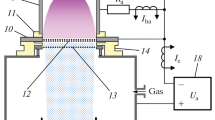Abstract
The results of theoretical studies of hysteresis transition between the diffuse and constricted modes of a dc glow discharge in argon are presented. It has been shown that the experimentally observed hysteresis of the current voltage characteristic (CVC) at the transition from the constricted to the diffuse mode is caused by the nonlocal formation of the electron energy distribution function (EEDF) while taking into account the heterogeneity of radial fields, namely, the diffusion of high-energy electrons capable of producing gas ionization from the central (constricted) region. The effect of the non-local formation of the EEDF has been described approximately by introducing the effective temperature of the high-energy part of the EEDF and solving the equation for the radial profile of the high-energy part of the EEDF.
Similar content being viewed by others
References
Yu. B. Golubovskii and R. Zonnenburg, Sov. Phys. JETP 49(2), 295 (1979).
G. M. Petrov and C. M. Fereira, Phys. Rev. E 59, 3571 (1999).
N. A. Dyatko, Yu. Z. Ionikh, I. V. Kochetov, et al., “Experimental and numerical-theoretical study of the constriction effect of glow discharge in argon”, in Proceedings of the All-Russian Conference on Physics of Low-Temperature Plasma-2007, (Petrozavodsk, 2007) 2, p. 136.
I. A. Shkurenkov, Yu. A. Mankelevich, and T. V. Rakhimova, “Modeling diffuse and constricted DC discharge in inert gases”, in Proceedings of the All-Russian Conference on Physics of Low-Temperature Plasma-2007, (Petrozavodsk, 2007) 1, p. 155.
J. Gunn, Solid State Communication 1, 88–91 (1963).
I. A. Shkurenkov, Yu. A. Mankelevich, and T. V. Rakhimova, Plasma Phys. Rep. 34(9), 845 (2008).
Yu. B. Golubovskii, A. K Zinchenko, and Y. M Kagan, Sov. Phys. JETP 47(7), (1977).
Physical Quantities: Handbook, Ed. by I. S. Grigoriev, E. Z. Meylikhov (Moscow, 1991) [in Russian].
Encyclopedia of the low-temperature plasma, Ed. by V. E. Fortov (Moscow, 2000), Vol. 1.
Yu. P. Raiser, Physics of gas discharge (Moscow, 1987) [in Russian].
A. V. Phelps, JILA Information Center Report (28), (1985).
V. I. Kotobov, J. Phys. D 39, R487–R506 (2006).
V. S. Marchenko, Sov. J. Plasma Phys. 85(2(8)), 500 (1983).
Author information
Authors and Affiliations
Corresponding author
Additional information
Original Russian Text © I.A. Shkurenkov, Yu.A. Mankelevich, T.V. Rakhimova, 2009, published in Vestnik Moskovskogo Universiteta. Fizika, 2009, No. 2, pp. 78–81.
About this article
Cite this article
Shkurenkov, I.A., Mankelevich, Y.A. & Rakhimova, T.V. Hysteresis transition between diffuse and constricted modes of dc discharge in argon. Moscow Univ. Phys. 64, 187–190 (2009). https://doi.org/10.3103/S0027134909020180
Received:
Published:
Issue Date:
DOI: https://doi.org/10.3103/S0027134909020180



